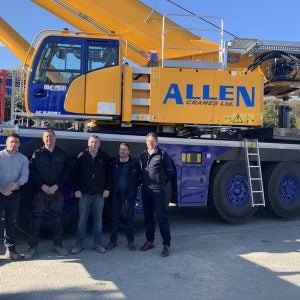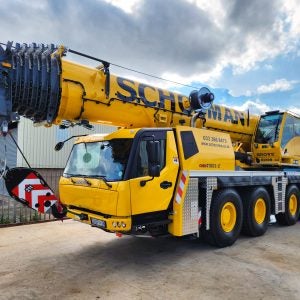The new crane can be easily transformed from a crawler crane (designated CC, like the rest of Terex-Demag’s crawler cranes) into a pedestal crane (PC). The 1,250t CC/PC 6800 (and the 1,000t CC/PC 5800) has a four-part car body, with attachment points extending diagonally in a star shape.

A drawing of the crane car body in CC 6800 crawler configuration
The attachment points are used in both crawler and pedestal configurations. When used as a CC-type crane, the crawler tracks fix to the end of the attachment points. In the PC configuration, the attachment points form the first half of a two section, star type, outrigger.

A drawing of the CC/PC 6800 in pedestal configuration
This concept increases the flexibility of the crane. In CC configuration, it offers all the standard advantages of a crawler. In PC configuration, the crane lacks mobility, but needs fewer parts (reducing transport costs) and is able to lift heavier loads at some points on the load chart.
This job demonstrated another advantage of the PC configuration: despite the marshy ground around the bridge, Havator only needed to sink piles at the point where the outrigger feet would stand, rather than building a road and concrete platform to support the entire crawler base.
Using the PC 6800, Havator was able to lift the old 320t, 51m long, Nyköpingsån River railway bridge away in one piece, working from dry land. Project manager Lars-Olof Carlsson said, “[This was] a truly groundbreaking project. Our technical solution is quicker and environmentally sound, and causes less disruption to traffic. Replacing something like this large, heavy railway bridge across Nyköpingsån river requires major lifting capacity.”
Havator explained that conventional techniques involving pile-driving, work bridge and bridge launching would have been vastly more time-consuming and would perhaps have disrupted the river environment. In addition, removing the work bridge would have repeated this environmental impact. As well as avoiding these environmental issues, Havator believes this approach is cheaper than standard techniques.
The 60t crane superstructure was flown to Skavsta Airport, about 4mi from the site. Other components came by road.
Related Files
CC/PC 6800 Technical Data






